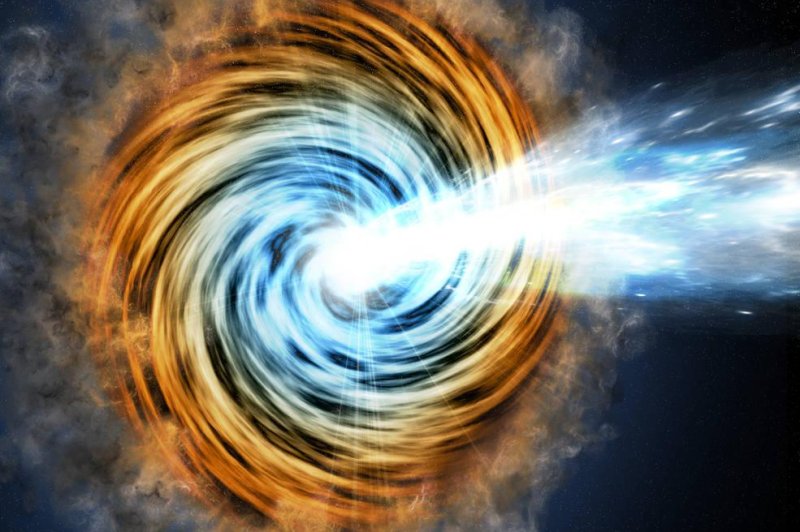An illustration of the blast of gamma ray jets emitted by the accretion disk of a supermassive black hole. Photo by M. Weiss/CfA
Jan. 30 (UPI) -- NASA's Fermi Gamma-ray Space Telescope has located the most extreme blazar yet. A blazer is a distant galaxy revealed by the emissions of a supermassive black hole at its center.
The newly identified blazer is the farthest yet imaged by Fermi. The blazer's light has been traveling for 12.43 billion light-years, meaning astronomers are seeing the distant galaxy as it was when the universe was just 1.4 billion years old.
"Despite their youth, these far-flung blazars host some of the most massive black holes known," Roopesh Ojha, an astronomer at NASA's Goddard Space Flight Center, said in a news release. "That they developed so early in cosmic history challenges current ideas of how supermassive black holes form and grow, and we want to find more of these objects to help us better understand the process."
The source of blazer radiation is the pair relativistic particle jets emanating from the accretion disks of distant supermassive black holes -- black holes boasting the mass of several million suns.
When blazar radiation reaches Earth, it arrives in the form of a full spectrum, but the jets' gamma rays, the highest-energy light, are what allow it to be identified by telescopes like Fermi. However, blazar radiation doesn't arrive as it originated. On its long journey through the cosmos, gamma rays become stretched by the expansion of the universe.
The degree to which the rays' wavelengths are stretched is called the redshift. By measuring the redshift of blazar radiation, researchers can estimate how far the light traveled. A recent survey of only the brightest blazars revealed blazars with redshifts between 3.3 and 4.31.
Analysis of blazar wavelengths has allowed scientists to estimate the size of the universe's largest and most distant supermassive black holes. Two of the supermassive black holes studied by Fermi boast masses of more than a billion suns.
"The main question now is how these huge black holes could have formed in such a young universe," said Dario Gasparrini, a researcher at the Italian Space Agency's Science Data Center. "We don't know what mechanisms triggered their rapid development."
Another recent study found the universe's earliest supermassive black holes likely began as large black holes and grew in spurts.
The picture of the early universe is getting clearer, but scientists think Fermi's latest exploits are only the beginning. There are many more revelations to come.
"We think Fermi has detected just the tip of the iceberg, the first examples of a galaxy population that previously has not been detected in gamma rays," said Clemson University astronomer Marco Ajello.















